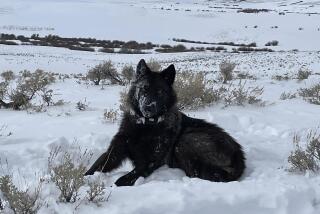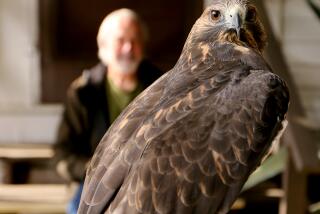Western States Crack Down on Budding Big-Game Farm Industry : Ranching: Officials say it is necessary to keep the deer, elk and other wildlife from spreading diseases, interbreeding and competing with native wild animals.
ACME, Wash. — Jim and Anita Rich were making a go of it much the way frontier settlers did, tending a farm on 80 acres of a sloppy-wet valley in northwestern Washington.
But the Riches weren’t raising crops or cows. They were raising exotic deer, 600 of them, for sale and for slaughter.
Now the future of that herd is in doubt.
The Riches moved here from Virginia four years ago and started the Pacific Northwest’s first large-scale commercial deer farm on land that once yielded corn, hay and peas. This year was to be their first profitable year. Instead, they could lose their farm and their livelihood.
The state Department of Wildlife imposed emergency regulations this summer banning the importation, sale and transfer within the state of most deer, elk and other animals commonly used in wildlife ranching and farming operations. The regulations halted a budding game-farm industry in its tracks.
The Wildlife Department says the regulations are necessary to prevent game-farm animals from spreading diseases to, interbreeding with and competing with native wild animals.
“We were trying to get out in front of this because this is an emerging industry,” says Curt Smitch, director of the state Wildlife Department. “We don’t know for sure whether we have a problem in this state, but animals have come here from states that have diseases.”
Jim Rich accuses Smitch of overreacting and of zealously crusading to wipe out the game-farm industry across the nation.
“With what the department has done, we’re going to end up losing our farm,” Rich says. “We’re probably the hardest hit because we simply devoted everything we had into trying to make this farm run.”
Just last spring, the Riches had locked up tens of thousands of dollars in sales for sika breeding doe, asking price $1,500-$1,700 a head. They were negotiating with a Japanese company to expand their operation by 40 to 60 acres and penetrate Pacific Rim markets.
But the Japanese deal fell through, the new state regulations scared away customers and Rich says he is left with 600 animals nobody wants.
“I’m trying to sell the animals at bargain-basement, fire-sale prices rather than shoot them, because I can’t afford to feed them,” he says.
Across the Wild West, states have been cracking down on a blossoming game-farm industry. Wyoming has essentially outlawed big-game farms. California imposed emergency regulations shortly after Washington did. Oregon is considering draft regulations.
No state wants to be a game-farm dumping ground, says Chris Wheaton, big-game staff biologist for the Oregon Department of Fish and Wildlife.
Smitch’s department points to the experiences of other states and Canada.
In Colorado and Montana, several elk herds were destroyed last year because of tuberculosis infection. The source was traced to Nebraska, where a rancher sold infected elk in the late 1980s to buyers in Colorado and Montana. Infected or exposed cattle and deer herds in Nebraska were later destroyed.
About 2,500 game-farm animals were destroyed in Alberta, Canada, after a major outbreak of TB in December, 1991. The Canadian government paid $15 million in compensation to the affected game-farm operators.
“What you’re seeing now is recognition by various wildlife departments in the Western United States and also in Canada, not that they have been turning a blind eye, but just that they were unaware of what’s going on and now they realize there are some valid concerns for wildlife,” says Margo Pybus, wildlife disease research biologist with the Alberta Fish and Wildlife Division.
No one knows exactly how many game farms there are, but most of the Western states have seen an explosion in the industry since the mid-1980s. Many were seeking to cash in on the success of farmers in New Zealand, a country with no native deer species. Deer were imported into the country in the last century, and their numbers multiplied so fast that ranchers began fencing them in and raising them for profit.
Much of the venison served in upscale restaurants in the United States today comes from New Zealand.
Game farmers such as Rich make money primarily by selling breeding doe to others looking to get into the business. The two other major customers are restaurants, which buy deer meat, and Asian countries, where elk velvet antlers are prized as medicine.
Rich says that when he started his business in 1988 he told the state wildlife and agriculture departments of his plans and tested all his animals for TB and brucellosis, another disease found in cattle. He quarantined his farm until his animals got a clean bill of health.
“We wanted to make sure that we had done things right from the beginning,” Rich says.
The Wildlife Department didn’t express any interest then, so Rich says he was perplexed when the department suddenly proposed emergency regulations this summer.
Smitch says the department wasn’t aware of the scope of the potential problems until the fall of 1991, when state wildlife directors met in Arkansas and swapped stories of game-farm woes in their states.
“From where I sit, this is a national problem,” Smitch says. “My goal is not to ban the industry. My goal is to protect the wildlife of the state of Washington.”
But even Smitch acknowledges that of the three game-farm threats he cites--spread of TB and other diseases to animals in the wild, interbreeding with wild animals and competing for their habitat--not a single case has ever occurred in Washington.
In fact, there has never been a confirmed case of bovine TB--a lung disease found mostly in cows--in wildlife in the United States, says Mitch Essey, senior staff veterinarian with the cattle diseases and surveillance staff at the U.S. Department of Agriculture’s Animal and Plant Health Inspection Service.
Rich says the deer he raises are too different to mate with wild deer in Washington. And scientists say most farm-reared animals probably couldn’t adapt to the wild anyway.
“The probability is not so much that game-farm animals would escape and interbreed with wild animals, but that they would die,” says George Beran, professor of preventive medicine at the College of Veterinary Medicine at Iowa State University and an authority on the prevention of diseases that affect humans and animals.
Washington’s emergency regulations were challenged in federal court and have since been loosened to allow game farmers to breed their animals. European fallow deer, common on many game farms, have also been exempted from the regulations.
But game farmers say the Wildlife Department’s initial reaction has damaged their industry beyond repair.
“The whole way they’ve gone about it has been asinine,” says deer farmer Jim Abbott in Oakville. “The thing people don’t realize is they effectively closed us, but every day these animals need to be fed. This costs money.”
More to Read
Sign up for Essential California
The most important California stories and recommendations in your inbox every morning.
You may occasionally receive promotional content from the Los Angeles Times.










